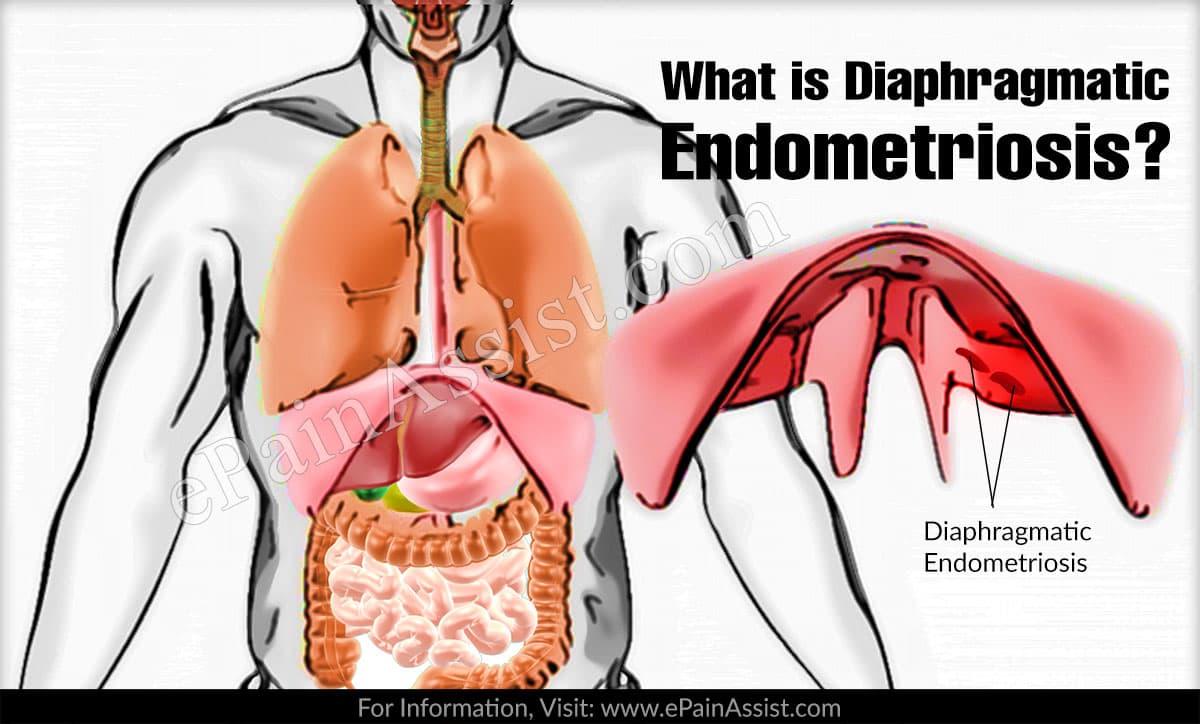What is Diaphragmatic Endometriosis?
Diaphragmatic Endometriosis is an extremely rare variant of endometriosis where the tissues that seem like the ones that line the uterus start growing in the diaphragm. The diaphragm separates abdomen from the chest and aids in breathing. Diaphragmatic Endometriosis may cause the female to have problems with breathing along with pain in the chest, neck, and shoulders. Studies estimate that only about 0.5% to 1% of females tend to have Diaphragmatic Endometriosis.[2]
In majority of the cases, endometriosis affects the pelvic organs and the surrounding areas Endometriosis as a single condition affects about 10% of females in the United States. It is categorized as pelvic and extrapelvic endometriosis depending on the where the tissues are growing anatomically. About 12% of extrapelvic endometriosis is later on diagnosed as Diaphragmatic Endometriosis.[1]

It has been observed that many people with Diaphragmatic Endometriosis remain undiagnosed for significant number of years. This is because the main focus of diagnosis in cases of endometriosis is in and around the pelvic regions. In some cases, Diaphragmatic Endometriosis is also misdiagnosed as conditions related to the gastrointestinal tract or cardiothoracic region.[1] This article gives an overview of some of the presenting feature of Diaphragmatic Endometriosis and ways to manage the condition.
Symptoms For Diaphragmatic Endometriosis
The primary symptom of Diaphragmatic Endometriosis is pain around the neck, shoulder, and chest. It is characterized as a dull ache which tends to worsen during the menstrual periods. Additional symptoms that can be seen in people with Diaphragmatic Endometriosis include stiffness along the chest, neck, and shoulder. Some females also complain of problems with breathing as a result of this condition. These symptoms tend to get worse just before the menstrual periods or during the periods.[2]
Even the pelvic organs are not spared in cases of Diaphragmatic Endometriosis. The symptoms experienced include pain around the pelvic region and the abdominal areas, dyspareunia, heavy bleeding during menstruation, and pain with voiding. The patient also experiences a sense of malaise and severe fatigue.[2]
In some cases, Diaphragmatic Endometriosis when it occurs in association with other forms of endometriosis can affect the fertility of a female as well. In such instances, surgery is the best way to remove the tissues interfering with the pregnancy and increases the chances of the female to conceive. Some females opt for IVF treatments if they are not able to get pregnant due to Diaphragmatic Endometriosis.[2]
What are the Treatment Options For Diaphragmatic Endometriosis?
As of now, there is no cure for Diaphragmatic Endometriosis. Treatments available are aimed at reducing the symptoms of Diaphragmatic Endometriosis and improving the quality of life of the patient. The treatment protocol for Diaphragmatic Endometriosis will be determined by the physician depending on the severity of the condition, how severe the symptoms are, age of the patient, and whether the patient wants to become pregnant [2].
If the symptoms of Diaphragmatic Endometriosis are mild, then there are no specific treatments required and over the counter anti inflammatories may suffice to control the symptoms. Hormonal therapy is given for females who have severe symptoms of Diaphragmatic Endometriosis. Birth control pills which are quite effective for treatment of Endometriosis work by reducing the amount of reproductive hormones that are released by the body. This reduces the process of ovulation which ultimately results in a significant decrease in the symptoms.[2]
If these treatments for Diaphragmatic Endometriosis are deemed ineffective then surgery will be recommended for the patient. The surgical procedures done to deal with the symptoms of Diaphragmatic Endometriosis include.[2]
Laparoscopic Surgery: This is basically done when the symptoms are severe and there is no response with hormonal treatments. This procedure involves inserting a laparoscope attached with a camera around the area of the endometrial tissues by making a small incision. The growths are then explored and the severity of the condition gauged. A biopsy sample may be collected of the growths for further analysis. In some cases, these growths are even removed laparoscopically.[2]
Abdominal Surgery: This is the most preferred surgical treatment for Diaphragmatic Endometriosis. It can be done either alone or in addition to the laparoscopic surgery. Incisions will be made in the abdominal wall and the tissues will be peeled until access to the diaphragm is gained. The growths will then be identified and removed. Since this surgery needs bigger incisions than the laparoscopic procedure, the patient will require general anesthesia. It should be noted that this procedure is only done in extreme cases of Diaphragmatic Endometriosis.[2]
In conclusion, Diaphragmatic Endometriosis is a rare variant of endometriosis in which the endometrial tissues start growing in the diaphragm. It results in the patient experiencing pain in the chest, neck, and shoulders. Additionally, the breathing of the patient also is affected. These symptoms tend to get worse just before or during the menstrual period.[1, 2]
As of now, there is no cure for Diaphragmatic Endometriosis but if the symptoms are severe then either laparoscopic surgery or an abdominal surgery may be quite effective in removing the adhesions or growths in the diaphragm and ease off the symptoms. If a female, experiences any of the symptoms mentioned above or suspects that she may have Endometriosis then it is best to consult with a physician to get evaluated and treated.[1,2]
